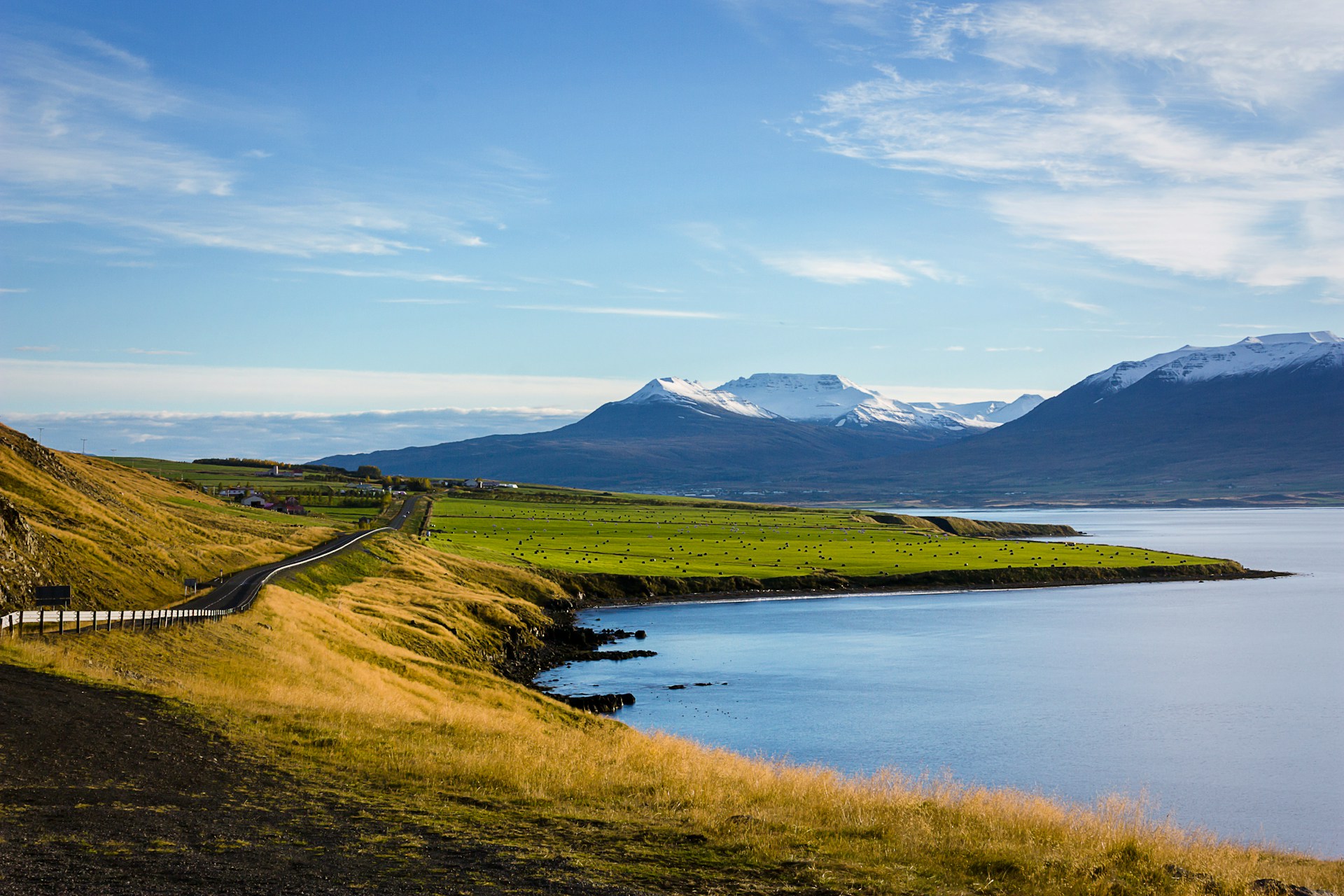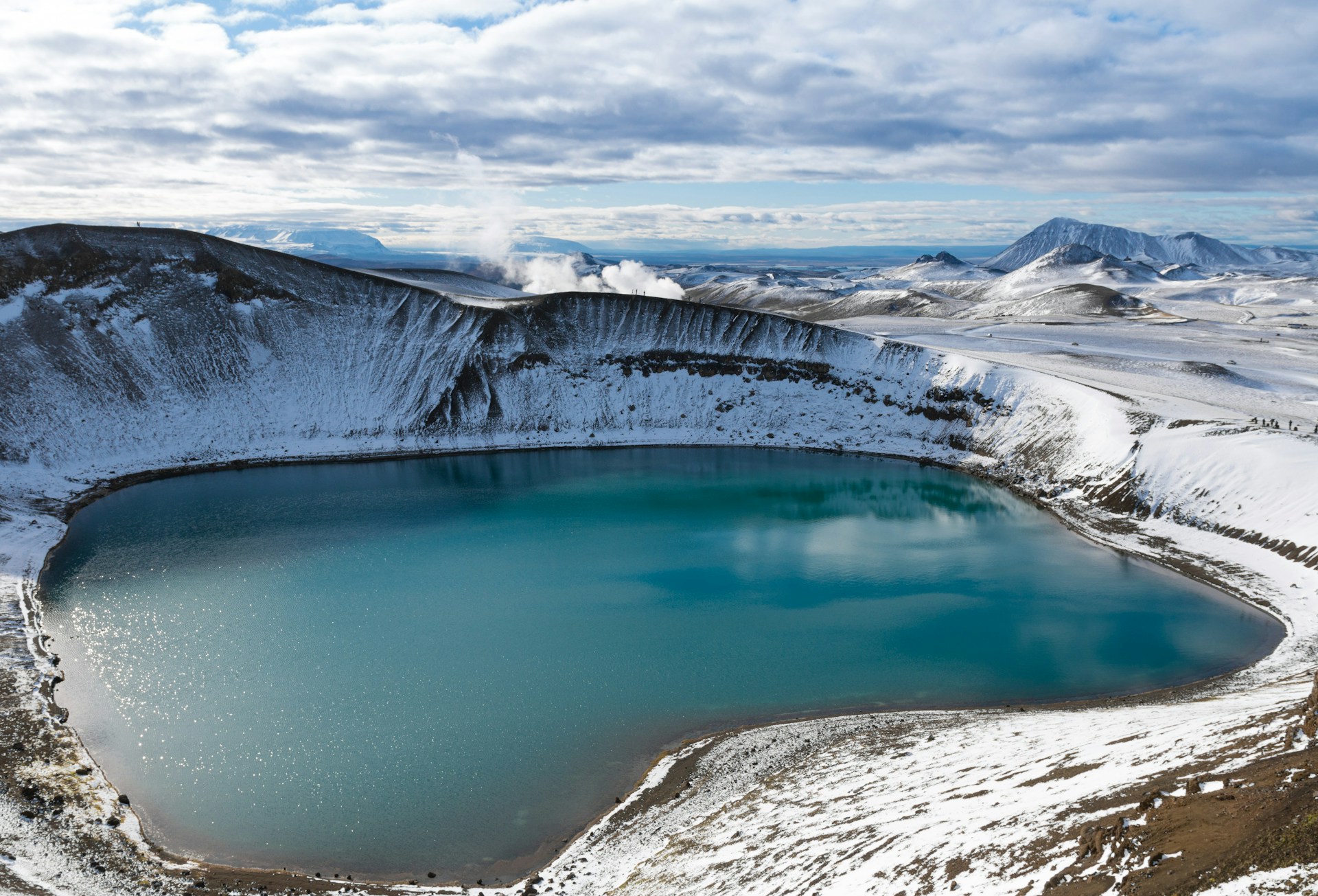The Golden Circle is a popular 300-kilometer tourist route in Southern Iceland, offering a mesmerizing journey through some of the country's most stunning natural wonders. The term "Golden Circle" is symbolic of the golden opportunities to explore Iceland's geothermal marvels, historical sites, and breathtaking landscapes.
As per data from the Icelandic Tourist Board, more than 80% of all visitors to Iceland choose this route, underscoring its appeal and importance. This 300-kilometer loop, starting and ending in Reykjavik, encompasses three primary attractions: Thingvellir National Park, the geothermal area of Geysir, and the stunning Gullfoss waterfall.
Beyond these major attractions, the Golden Circle also includes other natural wonders and activities such as the volcanic crater Kerið, the Faxi waterfall, and traditional Icelandic farms like Efstidalur and Friðheimar. In this comprehensive guide, we'll delve into the heart of Iceland's Golden Circle, exploring its key attractions, hidden gems, and the best ways to navigate this popular route.
Golden Circle Iceland Map With Highlighted Attractions
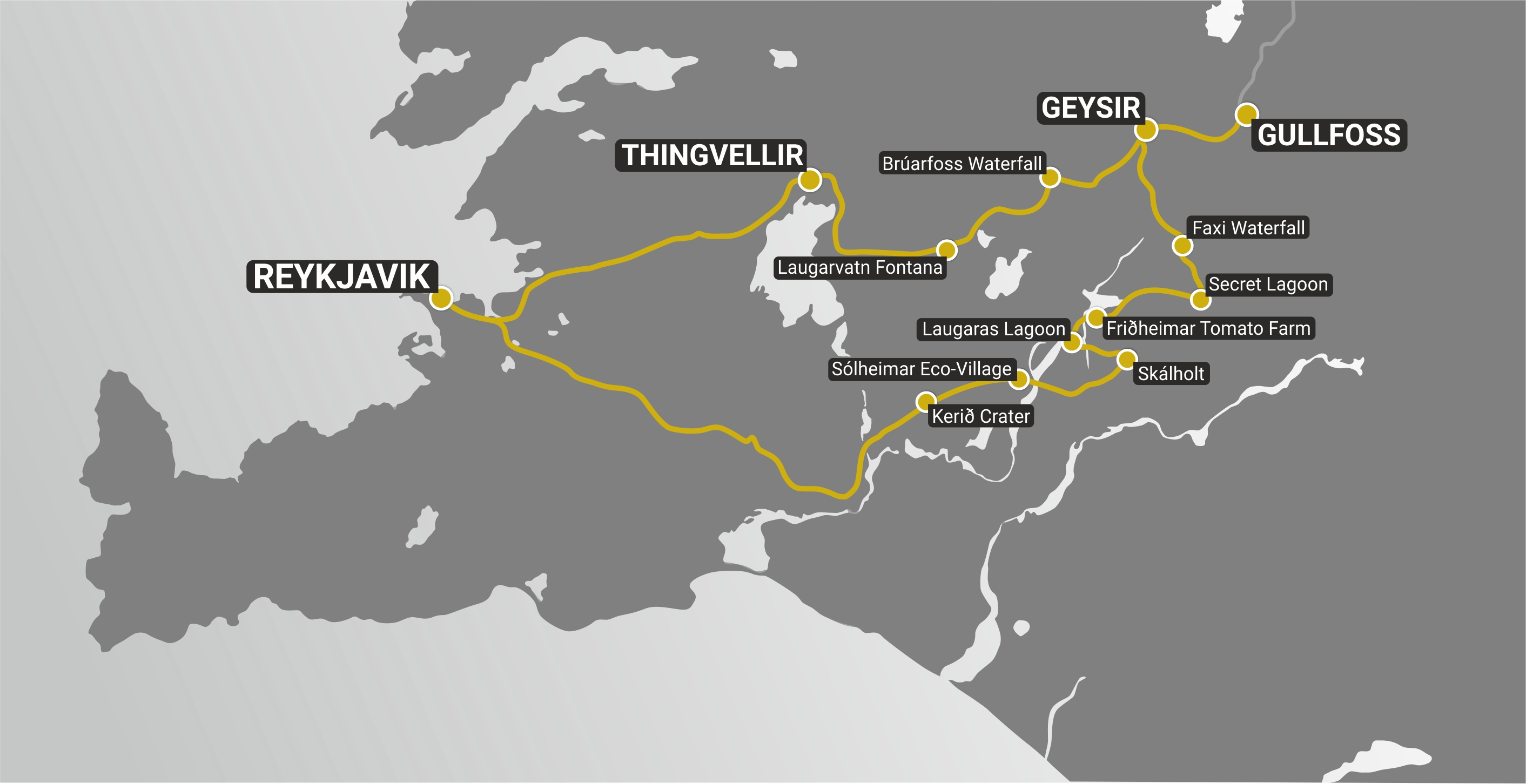
Major Attractions on the Golden Circle Route
The Golden Circle Route in Iceland is a journey through some of the most iconic and mesmerizing natural attractions the country has to offer. Among these, Thingvellir National Park, the Geysir Geothermal Area, and the Gullfoss Waterfall stand out as must-visit landmarks.
Thingvellir National Park

Location: About 40 kilometers northeast of Reykjavik.
Significance: A UNESCO World Heritage Site, Thingvellir is the site of Iceland's first parliament, the Althing, established in 930 AD. The park lies in a rift valley between the North American and Eurasian tectonic plates, offering unique geological features.
Highlights: Visitors can walk through the Almannagjá gorge, witness the Silfra fissure's crystal-clear waters, and explore historical sites such as the Law Rock (Lögberg).
Read More: Hiking in Thingvellir National Park
Geysir Geothermal Area
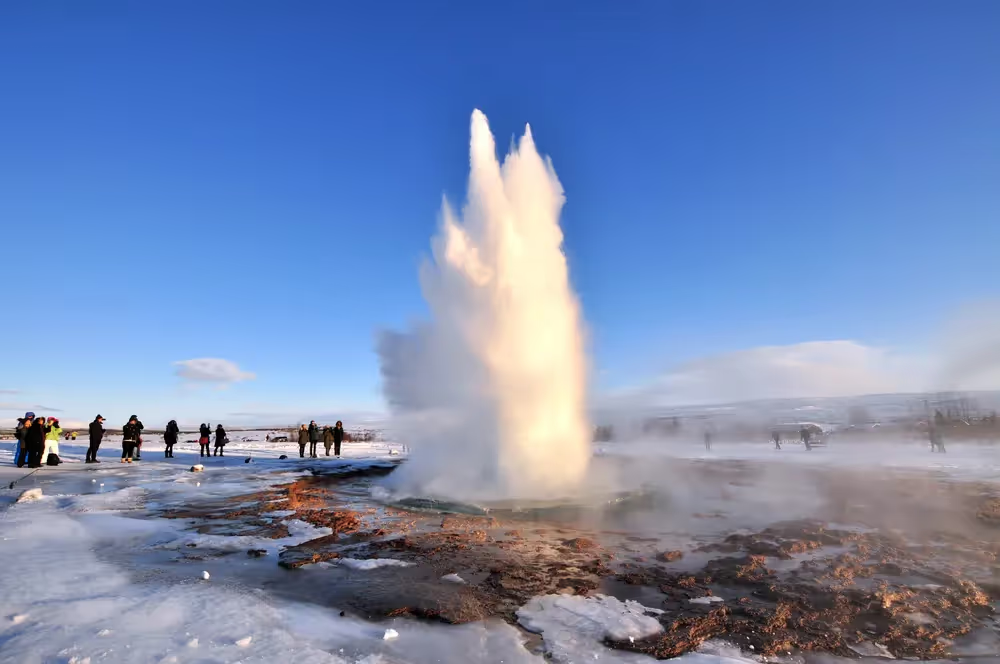
- Location: Approximately 60 kilometers from Thingvellir.
- Significance: Home to the original geyser, Geysir, after which all other geysers are named. While Geysir is now mostly dormant, the area remains geothermally active.
- Highlights: The main attraction is Strokkur, an active geyser that erupts every 5-10 minutes, shooting water up to 20-30 meters in the air. The area also features boiling mud pits, hot springs, and fumaroles.
Gullfoss Waterfall
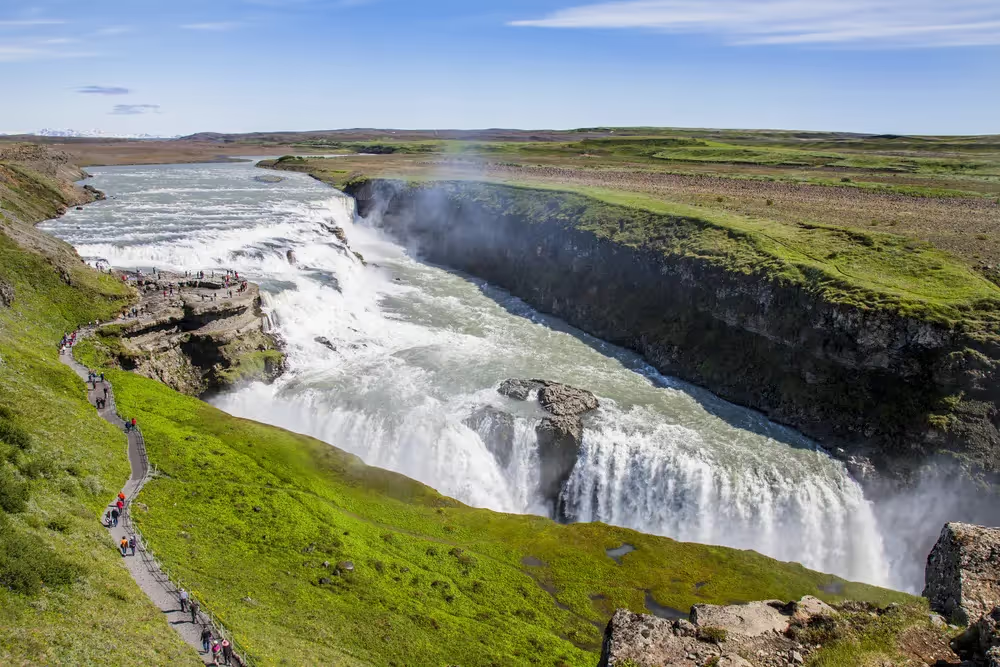
Location: About 10 kilometers from the Geysir Geothermal Area.
Significance: Known as the "Golden Falls," Gullfoss is one of Iceland's most iconic waterfalls. It is fed by the glacial river Hvítá.
Highlights: Gullfoss features a two-tiered cascade with a total drop of 32 meters. The waterfall plunges into a narrow canyon, creating a powerful spectacle. On sunny days, rainbows often form in the mist.
Also See: Complete Guide To Gullfoss Waterfall
Kerid Crater
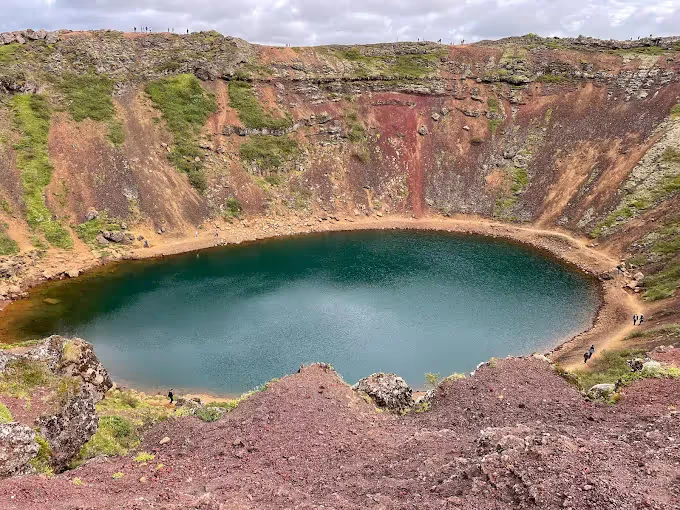
Location: Approximately 15 kilometers from Gullfoss, slightly off the main Golden Circle route.
Significance: A volcanic crater lake formed around 3,000 years ago, notable for its vivid blue water and the striking red volcanic rock surrounding it.
Highlights: Visitors can hike around the rim or descend to the water’s edge. The crater’s vibrant colors and unique geology make it a must-see stop.
Secret Lagoon

Location: Near the village of Flúðir, about 30 kilometers from Geysir.
Significance: One of Iceland's oldest natural hot springs, providing a relaxing geothermal bathing experience.
Highlights: The lagoon is surrounded by geothermal features, including a small geyser that erupts every few minutes. It's a more intimate alternative to the Blue Lagoon, offering a quieter and more authentic experience.
Best Golden Circle Tour Itinerary for Travelers

One-Day Golden Circle Itinerary
A one-day tour of the Golden Circle is a popular choice for many visitors to Iceland. Starting your day early, you can begin with a visit to the Þingvellir National Park. Spend a couple of hours here exploring the walking paths and soaking in the natural beauty. The park is a UNESCO World Heritage site and is known for its historical significance and geological wonders.
Next, head to the Geysir geothermal area, which is about a 50-minute drive from Þingvellir. Here, you can marvel at the hot springs and watch the Strokkur geyser erupt every few minutes. After lunch, make your way to the majestic Gullfoss waterfall, just a 10-minute drive from Geysir. Spend an hour or so here, enjoying the views and taking photographs. Finally, end your day with a relaxing dip in the Secret Lagoon or the Blue Lagoon before heading back.
Two-Day Golden Circle Itinerary
If you have more time to spare, a two-day itinerary allows you to explore the Golden Circle at a more leisurely pace. On the first day, visit Þingvellir National Park and the Geysir geothermal area, spending more time at each location to fully appreciate their beauty. Consider having lunch at one of the local restaurants near Geysir for a taste of traditional Icelandic cuisine.
On the second day, start with a visit to the Gullfoss waterfall, taking the time to hike the surrounding trails and enjoy the stunning views. Next, drive towards the South Coast, exploring other attractions along the Ring Road.
Consider staying overnight at one of the charming guesthouses or hotels in the area. For dinner, try a local restaurant and savor some fresh Icelandic seafood. The next morning, conclude your tour with a visit to the Blue Lagoon or Secret Lagoon, where you can relax and reflect on your Icelandic adventure.
Choose Your Golden Circle Driving Route
The Golden Circle is not a clearly defined route as we previously thought. Although the three main attractions driving the golden circle are widely recognized, the rest of the route is subject to variation. Although there is a "Classic" route, the specifics of it can vary depending on interpretation.
When you check Google Maps, you'll notice that the three tourist spots on the Golden Circle are not arranged in a circular pattern. Instead, they're situated mostly in a straight line to the east of Reykjavik.
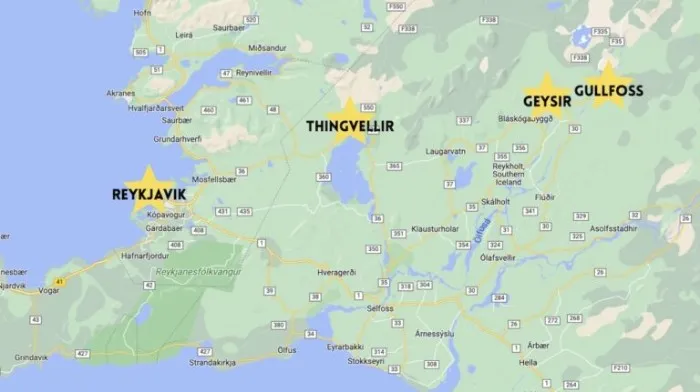
There are three primary choices for planning your driving route.
- Classic Golden Circle Route | Drive the full loop route and visit the three main attractions in the traditional order.
- Out-and-Back “Golden Line” Route | Please visit the three main attractions in the traditional order and then follow the same route back to your starting point.
Reverse Golden Circle Route | Typically, start the golden circle adventure with the last attraction and visit the other two in reverse order. Avoid driving a full loop.
We should examine these three route choices more closely.
Classic Golden Circle Route
- Attraction Order:
Thingvellir National Park > Geysir Hot Spring Area > Gullfoss waterfall
- Link to Route in Google Maps: Here
- Route Shape: Loop
- Total Driving Miles: 150
We recommend following the classic Golden Circle route which begins and ends in Reykjavik. The route includes three attractions that are visited in order from closest to furthest before returning to Reykjavik on a different road, creating a complete golden circle guided tour. This order is commonly used by travelers and tour groups for its convenience and efficiency.
Firstly, consider the timing of your three day trip. Among the three attractions, Thingvellir will probably take the most time. Visiting it first will allow you to have a more leisurely afternoon at the remaining two attractions without feeling the need to rush to include Thingvellir later.
A benefit of taking this route is that it creates a loop, giving you the opportunity to view different sights on the way back that you may not have seen on the way out. You have the option to make extra stops on the return trip based on your available time or desired travel duration.
After visiting the three main attractions, there are no officially planned stops on the journey back to Reykjavik. However, there are many fascinating sights to see on the way. Here are some recommended stops you can consider adding to your Golden Circle road trip:
- Faxi Waterfall
- Secret Lagoon
- Skálholt Cathedral
- Kerid Crater
Here's an example of what the extended route might look like. It includes additional stops, but will only increase the driving distance by approximately 15 miles.

Out-and-Back “Golden Line” Route
- Attraction Order: Thingvellir National Park > Geysir Hot Spring Area > Gullfoss waterfall
- Link to Route in Google Maps: Here
- Route Shape: Line
- Total Driving Miles: 145
To easily visit all three Golden Circle attractions from Reykjavik, you can use a straightforward route instead of following the circular path. This route is called the "Golden Line" and involves visiting the attractions in the golden circle in order and returning on the same path.

This alternative route is suitable for travelers who only want to visit the three main sites and continue with their other plans. It's a good option for those who don't need to see additional sites or sceneries on their way back.
In truth, after completing the three main attractions of the Golden Circle and departing from Gullfoss, the route you choose to return doesn't have a significant impact. Whether you follow the classic loop or retrace your original route, the difference in distance is only six miles. Your decision should be based on personal preference and whether you prefer to stick with a familiar route or explore something new on the way back.
I want to highlight the "Golden Line" route which Google maps suggests by default. However, you should be careful because if you don't pay attention, you might end up taking this route instead of the loop route that you intended to take.
Reverse Golden Circle Route
- Attraction Order: Gullfoss waterfall > Geysir Hot Spring Area > Thingvellir National Park
- Link to Route in Google Maps: Here
- Route Shape: Line (loop optional)
- Total Driving Miles: 145
A suggestion is to consider visiting the Golden Circle attractions in reverse order to reduce the crowds.
You can avoid the crowds by visiting Gullfoss waterfall and Geysir Hot Spring Area before heading to Thingvellir. Although you may encounter more people at Thingvellir, you'll still get to enjoy some peaceful moments earlier in the day.
Although there are some advantages to seeing the various Golden Circle tours in reverse, it is not a foolproof solution. While you may get lucky and avoid crowds, there is no guarantee. During the peak tourist season from May to August, you may encounter crowds no matter which order you choose to visit the Golden Circle.

If you don't intend to spend much time at the attractions or take extra stops, then we suggest the reverse Golden Circle route. It is ideal for travelers who want to see many places quickly, capture great photos, or avoid crowds.
To avoid crowds at Gullfoss, it's best to arrive as early as possible. The shortest route from Reykjavik passes through Thingvellir and Geysir, so you'll be taking the same route there and back. However, if you prefer to see something different on your way there, you could take the longer loop route, which only adds about 6 miles to your drive and doesn't require any extra stops.
To get to Gullfoss using the loop route, drive on Route 1 from Reykjavik and keep going north on Route 35.
Here is a link to that route.
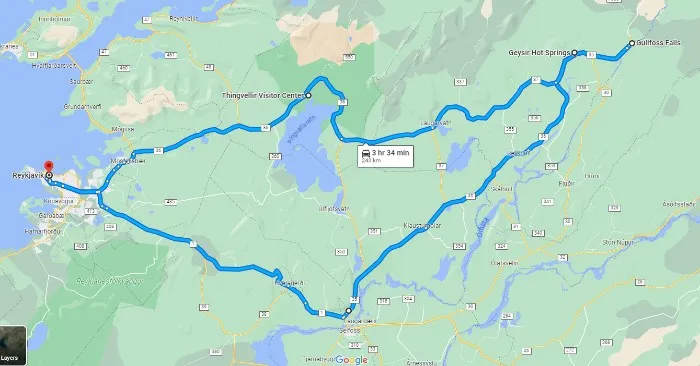
Embarking on Your Golden Circle Tour: Self-Drive vs Guided Tours
Whether you're visiting Iceland for the famous waterfalls, geothermal hot springs, or the chance to drive around the Golden Circle, choosing the right tour option can significantly enhance your experience. Travelers generally opt for either self-drive tours or guided tours, each offering its unique advantages.

Self-Drive Golden Circle Tours
A self-drive tour allows you to explore all the highlights of the Golden Circle at your own pace. You have the freedom to visit the main attractions when you wish, stay for as long as you like, and even deviate from the standard route to discover lesser-known sights. This option is ideal for those who prefer having control over their itinerary and enjoy the adventure of driving in a new country.
Planning Your Self-Drive Tour
When planning your self-drive tour, several factors should be taken into consideration:
- Car Rental: Renting your own car is a crucial part of a self-drive tour. Ensure you choose a vehicle that suits the terrain and weather conditions. In winter, a 4x4 is recommended due to icy roads. Also, make sure to familiarize yourself with Iceland's driving laws before embarking on your journey.
- Golden Circle Map: Having a detailed Golden Circle map will help you navigate the route more efficiently. This map should highlight all the main attractions, including Þingvellir National Park (where you can see the North American tectonic plates and the Mid-Atlantic Ridge), the Geysir geothermal area, and the Gullfoss waterfall.
- Time of Visit: The best time to visit the Golden Circle depends on what you want to see. If you're interested in witnessing Iceland's famous golden circle under the midnight sun, summer is the ideal season. Long daylight hours allow for extended exploration. However, visiting the Golden Circle in winter offers a completely different experience, with the possibility of seeing the Northern Lights.
- Itinerary Planning: Plan your itinerary carefully to make sure you can cover all the attractions within your available time. A typical self-drive tour might take half a day, but if you want to spend more time at each location or explore additional sights, consider spreading your tour over two stages or even two days.
- Prepare for the Weather: Icelandic weather can be unpredictable. Dress warmly and in layers, even in the summer. Always check the weather forecast and road conditions before heading out.
Other Things to Do in the Golden Circle, Iceland
Apart from its iconic attractions like Þingvellir National Park, the Geysir geothermal area, and Gullfoss waterfall, the Golden Circle also offers a variety of other exciting activities. From exploring volcanic craters to relaxing in geothermal baths, here are some additional experiences you might want to add to your itinerary.
1. Snowmobiling on Langjökull Glacier
Boost your Golden Circle adventure by adding a snowmobiling experience on Langjökull Glacier. As Iceland's second-largest glacier, Langjökull provides an ideal terrain for this thrilling activity.
Guided tours usually include all necessary equipment and safety instructions, ensuring a fun and safe experience even for beginners. As you zoom across the icy landscape, take a moment to appreciate the sweeping views of the surrounding mountains and valleys.
2. Relax in the Secret Lagoon
Add a touch of relaxation to your Golden Circle tour with a dip in the Secret Lagoon. Located in the village of Flúðir, this geothermal pool is one of the oldest in Iceland.
The warm waters of the Secret Lagoon offer a tranquil spot to unwind and soak in the stunning scenery. With temperatures staying around 38-40°C year-round, this natural hot spring is a delightful stop regardless of the season.
3. Horseback Riding
Experience the Golden Circle from a different perspective by going on a horseback riding tour. Icelandic horses are small, sturdy, and known for their unique gait called the tölt, which provides a smooth ride over various landscapes.
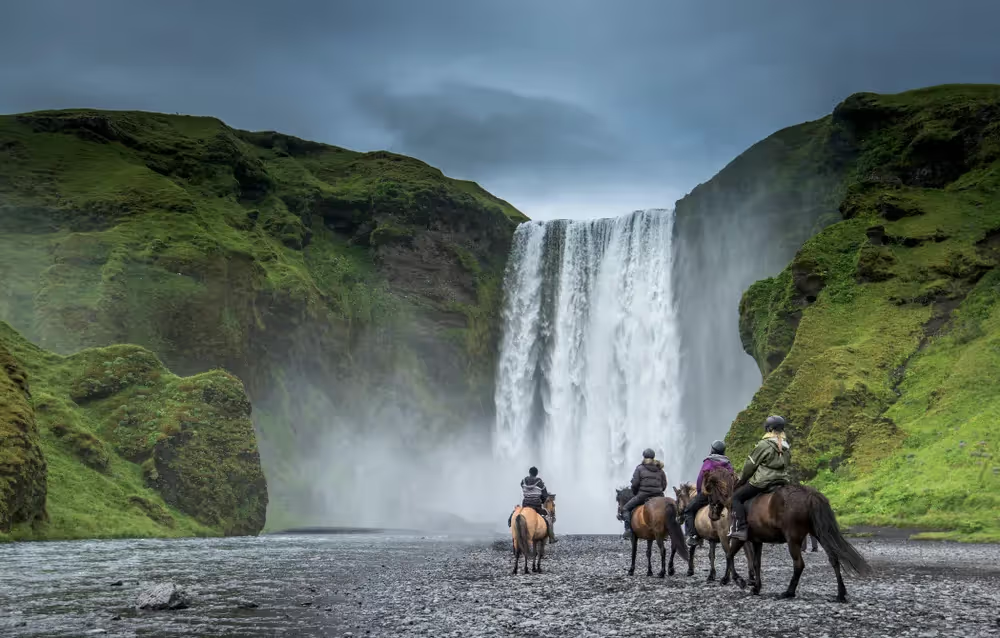
Riding tours generally cater to all experience levels, making this a fun activity whether you're an expert rider or trying it out for the first time. As you trot through fields, along rivers, and past geological wonders, you'll gain a deeper connection with Iceland's spectacular nature.
4. Snorkeling or Diving in Silfra
For a truly unique experience, consider snorkeling or diving in the Silfra fissure. Located within Þingvellir National Park, Silfra is a rift formed between the North American and Eurasian tectonic plates.
The glacial water that fills Silfra is incredibly clear, with visibility often exceeding 100 meters. This allows you to see the stunning underwater landscapes in vivid detail. Whether you choose to snorkel on the surface or dive deeper into the fissure, exploring Silfra is a once-in-a-lifetime adventure.
5. Hiking and Bird Watching
The Golden Circle offers ample opportunities for hiking and bird watching. The diverse landscapes, from lava fields to lush valleys, provide a variety of trails for all fitness levels.
Bird enthusiasts will be delighted with the variety of species found in the area, particularly during the summer months. Bring your binoculars and keep an eye out for birds like the Arctic Tern, the Red-Throated Loon, and the White-Tailed Eagle. Always remember to respect the wildlife and keep a safe distance.
6. Northern Lights Hunting
A visit to the Golden Circle in winter could give you a chance to witness the spectacular Northern Lights. The area's remote location away from city lights provides ideal conditions for viewing this natural phenomenon.
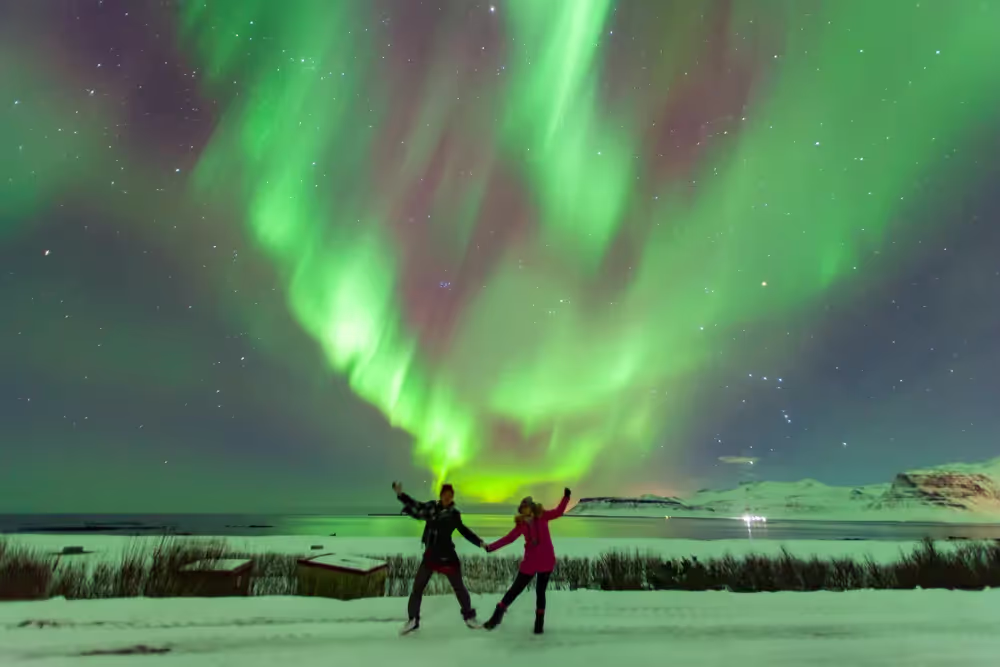
However, sightings are never guaranteed, as they depend on solar activity and clear weather. It's recommended to check the forecast and plan your Northern Lights hunt on a night with little to no cloud cover. Despite the unpredictability, the potential reward of seeing the aurora borealis makes the hunt worthwhile.
Plan Your Golden Circle Adventure with Us
Experience the breathtaking beauty of Iceland with a meticulously planned tour through the iconic Golden Circle. At "Golden Circle Day Tour," we ensure you don't miss out on any of the must-see sights; from the geological wonders of Kerið Crater Lake and Silfra fissure to thrilling adventures like snowmobiling on Langjökull Glacier, your adventure is our priority.
Ready to create unforgettable memories in the heart of Iceland? Start planning your Golden Circle adventure with us today. Visit our website or contact us to book your tour. Let's embark together on a journey that will stay with you forever!



.jpg)
%20(1).webp)
.jpg)



